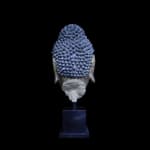Yuan Dynasty Stucco Buddha Head, 1260 CE - 1368 CE
Stucco
25
AM.0129
Further images
The first evidence of the development of Buddhism in China dates to the early period of the Han Dynasty in the 2nd Century BC. It was the trade conducted along...
The first evidence of the development of Buddhism in China dates to the early period of the Han Dynasty in the 2nd Century BC. It was the trade conducted along the myriad of caravan routes, usually referred to collectively as the ‘Silk Road’, that helped to transmit this faith from India to China. Progress was gradual as Buddhism had to contend with the indigenous belief systems, Daoism and Confucianism. By the period of the Tang Dynasty (618-906 AD) however it was firmly established and Chinese artists had developed a sophisticated range of styles and forms to deal with the demand for images.
This large stucco Buddha head was produced during the Yuan Dynasty, probably dating to the fourteenth century. It is exceptional for its size and polychromy. The face and elongated ears (a reference to the heavy jewellery that the Buddha used to wear before enlightenment) have been gilded in gold. The red undercoat that was placed beneath the gilding to add to the warmth to the gold is now visible in many places. Although unintentional, the effect is dramatic especially given the contrast with the blue pointed curls that adorn the head. The conventional protuberance, or ushnisha, is clearly visible at the top. The pupils of the downcast eyes are inlaid with a black stone and there are traces of black paint on the eyebrows and moustache. The head is in excellent condition with only minor repairs to some of the pointed curls on the reverse. It would make a striking and colourful addition to any collection.
This large stucco Buddha head was produced during the Yuan Dynasty, probably dating to the fourteenth century. It is exceptional for its size and polychromy. The face and elongated ears (a reference to the heavy jewellery that the Buddha used to wear before enlightenment) have been gilded in gold. The red undercoat that was placed beneath the gilding to add to the warmth to the gold is now visible in many places. Although unintentional, the effect is dramatic especially given the contrast with the blue pointed curls that adorn the head. The conventional protuberance, or ushnisha, is clearly visible at the top. The pupils of the downcast eyes are inlaid with a black stone and there are traces of black paint on the eyebrows and moustache. The head is in excellent condition with only minor repairs to some of the pointed curls on the reverse. It would make a striking and colourful addition to any collection.









